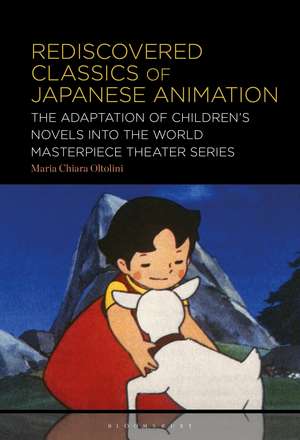Rediscovered Classics of Japanese Animation: The Adaptation of Children’s Novels into the World Masterpiece Theater Series
Autor Maria Chiara Oltolinien Limba Engleză Hardback – 21 feb 2024
Preț: 540.65 lei
Preț vechi: 774.19 lei
-30% Nou
Puncte Express: 811
Preț estimativ în valută:
103.46€ • 110.63$ • 86.26£
103.46€ • 110.63$ • 86.26£
Carte tipărită la comandă
Livrare economică 17 aprilie-01 mai
Preluare comenzi: 021 569.72.76
Specificații
ISBN-13: 9781501389900
ISBN-10: 1501389904
Pagini: 288
Ilustrații: 30 bw illus
Dimensiuni: 152 x 229 x 24 mm
Greutate: 0.56 kg
Editura: Bloomsbury Publishing
Colecția Bloomsbury Academic
Locul publicării:New York, United States
ISBN-10: 1501389904
Pagini: 288
Ilustrații: 30 bw illus
Dimensiuni: 152 x 229 x 24 mm
Greutate: 0.56 kg
Editura: Bloomsbury Publishing
Colecția Bloomsbury Academic
Locul publicării:New York, United States
Caracteristici
Broadens discussion on the dissemination and renegotiation of western values and role models in children's fiction, also in relation to the burgeoning "girls' culture" (shôjo bunka)
Notă biografică
Maria Chiara Oltolini has a BA, MA, and PhD from Università Cattolica del Sacro Cuore of Milan, Italy, where she has been working as a Teaching Assistant in Semiotics and History and Language of International Cinema for several years. In 2017, she was a visiting scholar at Cardiff University, UK as part of her PhD program. Her research interests include adaptation as a form of intermedia and intercultural expression, focusing on the relationships between Japanese animation and Children's literature.
Cuprins
IntroductionPart I: Adapting Children's Fiction in JapanChapter 1: Children's Literature in the Japanese History of TranslationChapter 2: Japanese Animation and Children's LiteratureChapter 3: Nippon Animation's "World Masterpiece Theater"Chapter 4: Framing the "Meisaku" GenrePart II: Case HistoryChapter 5: From "Anne of Green Gables" to "Akage no An"Chapter 6: From "A Little Princess" to "Shôkôjo Sêra"ConclusionsBibliographyIndex
Recenzii
This is one of the few books that touch upon Japanese animation and children's literature. It is very well-written and a "must read" for teachers of Japanese animation, Japanese literature, and children's literature.
Maria Chiara Oltolini explores the adaptation of western children's literature into Japanese animation, focusing on "World Masterpiece Theater" -and dives into the pre-WW2 origins, and the subsequent Post-war occupation and boom years of anime as she shines a light into a relatively unexplored corner of the back and forth relationship between western storytelling and the Japanese anime/manga field. In the process, she uncovers more, such as for example, in her words, "how Western novels contributed to the rise of modern juvenile fiction since the Meiji era, in the second half of the nineteenth century."
Building on the published works of others and citing numerous Japanese, English and other languages sources, Maria Chiara Olitini's interdisciplinary research not only provides us the historical and literary backgrounds of the well-known World Masterpiece Theater but also gives a rich analysis of the adaptations and transformations of the original Western children literature in the animation form. Her work helps us to further understand the international success of Japanese postwar animation and in particular, the Japanese inclination towards animating children literature classics from the Western world and the subsequent cultural interpretation, reshaping and animated imagery realization of the stories.
Maria Chiara Oltolini explores the adaptation of western children's literature into Japanese animation, focusing on "World Masterpiece Theater" -and dives into the pre-WW2 origins, and the subsequent Post-war occupation and boom years of anime as she shines a light into a relatively unexplored corner of the back and forth relationship between western storytelling and the Japanese anime/manga field. In the process, she uncovers more, such as for example, in her words, "how Western novels contributed to the rise of modern juvenile fiction since the Meiji era, in the second half of the nineteenth century."
Building on the published works of others and citing numerous Japanese, English and other languages sources, Maria Chiara Olitini's interdisciplinary research not only provides us the historical and literary backgrounds of the well-known World Masterpiece Theater but also gives a rich analysis of the adaptations and transformations of the original Western children literature in the animation form. Her work helps us to further understand the international success of Japanese postwar animation and in particular, the Japanese inclination towards animating children literature classics from the Western world and the subsequent cultural interpretation, reshaping and animated imagery realization of the stories.
